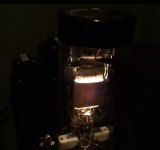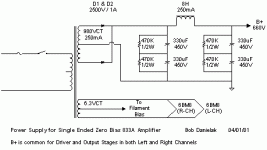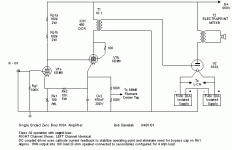Talking of photos, any chance of a series of low light shots to show off the 833c glow?
If you watch the video in post #707, there's a point in the middle where I turn the lights down - you can see the glow then.
Found this low voltage 833 amp.
phil
The metal plate 833a has its getter deposited on the plate and it needs to be at a minimum temperature to function. If the plate is not at least glowing dull red, the 833 is effectively running without a getter. Not good for tube life.
So I've been following this thread since Magz started it and last night I had the pleasure of seeing and listening to the work in person. Anyone following along knows the amount of work and craftsmanship that went into these. The photos do not convey the physical scale of the amps..they are big.
We listened for a couple of hours and I can report that the system sounds wonderful...all you expect from an SET with the added plus of LOTS of power and great bass. There were no oscilloscopes multimeters or microphones..just ears.
I know we were listening to the whole system and it is my observation that Magz has a very well worked out rig from user interface to speakers it just plain worked, was easy to use, and most importantly sounds awesome.
Evan
We listened for a couple of hours and I can report that the system sounds wonderful...all you expect from an SET with the added plus of LOTS of power and great bass. There were no oscilloscopes multimeters or microphones..just ears.
I know we were listening to the whole system and it is my observation that Magz has a very well worked out rig from user interface to speakers it just plain worked, was easy to use, and most importantly sounds awesome.
Evan
Because the sensor of your camera isn't corrected for human eyes. Maybe an infrared filter helps.
Love the 6E5P - I bought 50 of them so I don't run out.
Funny thing is, the Monolith OPT and choke are actually black, a black metallic that in normal light looks pretty close to the new covers in color. Whenever I take a picture, though, the metallic particles seem to catch the light and make them look grey...they're most definitely not.
So I've been following this thread since Magz started it and last night I had the pleasure of seeing and listening to the work in person. Anyone following along knows the amount of work and craftsmanship that went into these. The photos do not convey the physical scale of the amps..they are big.
We listened for a couple of hours and I can report that the system sounds wonderful...all you expect from an SET with the added plus of LOTS of power and great bass. There were no oscilloscopes multimeters or microphones..just ears.
I know we were listening to the whole system and it is my observation that Magz has a very well worked out rig from user interface to speakers it just plain worked, was easy to use, and most importantly sounds awesome.
Evan
Thanks, Evan. It was a pleasure having you over (and thanks for the wine!). It's good to get an independent confirmation of what I was hearing - you know that fatherly pride can sometimes obscure the truth about one's creations...glad to hear that you liked them!
Thanks. Regarding the Youtube video...it's on hold after one of the Pyrex cylinders around the tube developed a crack - talking with the supplier, Greatglas, located in Delaware, they say that can happen occasionally when stresses develop from the holes being drilled in them.
They offered to replace it free of charge (great service!), so I sent it off to them last night. This time they will melt the holes in the glass instead of drilling them, and that should avoid any stresses being developed.
Here's a pic of the crack. Obviously I didn't want to run the amps like that and risk the glass shattering from the thermal cycling.
It's not too bad to do stress relief. With Plexiglass you just put the part into boiling water for a few min after machining, and the stress is relieved. With Pyrex, you warm the glass with a torch or in a furnace after cutting to do the same.
...anyone know of a good 2300V regulator???!!!
Being from Central NJ, you might know pppl.gov. We built 40kv 60A series regulators (gated) using Eimac 8973, as well as some mighty big amps using 8974 and others. The 2300V regulator would force you to use another chassis, cooling system, etc. It's not like a 400-500v 6880 regulator because of the clearances for HV. We used a floating (at the output voltage) tube deck, 450V on the screens, and grid drive via fiber optic cable from a regulator board running at ground potential.
Shunt, primary, or negative leg regulation would be better, but still won't fit your current volume.
My recommendation would be leave 'em alone and kick back and enjoy the music!
Congratulations on a magnificent build. My summer job in college was babysitting a pair of AM transmitters (Colllins and Westinghouse), each of which had 4x833. The most photogenic tube ever made IMO.
Last edited:
It's not too bad to do stress relief. With Plexiglass you just put the part into boiling water for a few min after machining, and the stress is relieved. With Pyrex, you warm the glass with a torch or in a furnace after cutting to do the same.
I received another cylinder and ended up drilling my own holes with a diamond-tipped rotary drill bit on a Dremel, while running a stream of water over the drill hole. Took a few minutes for each hole but it seems to have worked out well. So far no cracks.
Being from Central NJ, you might know pppl.gov. We built 40kv 60A series regulators (gated) using Eimac 8973, as well as some mighty big amps using 8974 and others. The 2300V regulator would force you to use another chassis, cooling system, etc. It's not like a 400-500v 6880 regulator because of the clearances for HV. We used a floating (at the output voltage) tube deck, 450V on the screens, and grid drive via fiber optic cable from a regulator board running at ground potential.
Shunt, primary, or negative leg regulation would be better, but still won't fit your current volume.
My recommendation would be leave 'em alone and kick back and enjoy the music!
Congratulations on a magnificent build. My summer job in college was babysitting a pair of AM transmitters (Colllins and Westinghouse), each of which had 4x833. The most photogenic tube ever made IMO.
I just saw this post. Very interesting.
I solved the regulation issue by regulating the AC itself, instead of the B+. Each monoblock runs off a PS Audio P5 regenerator, set to a regulated 117V output, which is the rating of the 2500V power transformer. Output tube current is solid as a rock now wherever I set it. I already had one of the P5s, so I bought another and balanced the loads (source, tube preamp and mono amps) so that both P5s are under close to the same load. Both are running at ~84% of capacity.
Found this low voltage 833 amp.
phil
Mr Sakuma uses in one of his amps a 845 as 500V driver
I just saw this post. Very interesting.
I solved the regulation issue by regulating the AC itself, instead of the B+. Each monoblock runs off a PS Audio P5 regenerator, set to a regulated 117V output, which is the rating of the 2500V power transformer. Output tube current is solid as a rock now wherever I set it. I already had one of the P5s, so I bought another and balanced the loads (source, tube preamp and mono amps) so that both P5s are under close to the same load. Both are running at ~84% of capacity.
I thought I had read the whole thread but I must have missed that. Perfect.
I received another cylinder and ended up drilling my own holes with a diamond-tipped rotary drill bit on a Dremel, while running a stream of water over the drill hole. Took a few minutes for each hole but it seems to have worked out well. So far no cracks.
The application itself should gradually relieve the stress.
The application itself should gradually relieve the stress.So only a flaw in the Pyrex would cause a crack.
The cylinders DO get hot when the tubes are on...I suppose that could help a little, not sure whether they get hot enough to affect the tempering, though. So far, so good.
The cylinders DO get hot when the tubes are on...I suppose that could help a little, not sure whether they get hot enough to affect the tempering, though. So far, so good.
Looking at the specs, tempering will happen pretty slowly. Even though the 833 anode is at about 800C at full dissipation the envelope outer surface must be maintained below 270C or so to prevent failure. So the Pyrex will be somewhat cooler than that. Still hot though. It might temper the glass as quickly as a fine scotch ages.
Last edited:
I try to find the UPSC600 diodes for cathode bias, but I can not find, I can use this model CREE CSD20060, any more?.
Actually, my schematic only shows those UPSC diodes because I had a spice model for them. I actually used Cree 600V, 1A SiC diodes in the build.
- Home
- Amplifiers
- Tubes / Valves
- The Midlife Crisis - My 833C Amp Build


